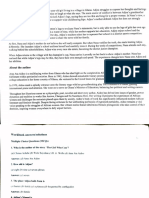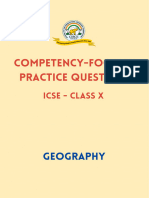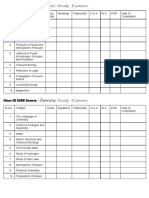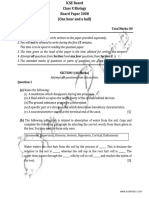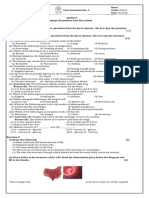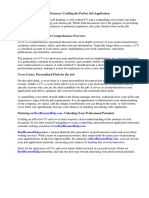ICSE Biology X
ICSE Biology X
Uploaded by
harshchoudhary09831Copyright:
Available Formats
ICSE Biology X
ICSE Biology X
Uploaded by
harshchoudhary09831Copyright
Available Formats
Share this document
Did you find this document useful?
Is this content inappropriate?
Copyright:
Available Formats
ICSE Biology X
ICSE Biology X
Uploaded by
harshchoudhary09831Copyright:
Available Formats
PREFACE
With a growing emphasis on competency-based education globally, the educational landscape
in India has also steered towards high-quality learning experiences that allow learners to
incorporate critical thinking and problem-solving approaches. This approach goes beyond rote
memorisation and focuses on developing the skills and knowledge that students need to apply
in their real-world scenarios.
The Council for the Indian School Certificate Examinations (CISCE), as a national-level
progressive examination board, has taken several steps to infuse competency-based education
in CISCE schools through teacher capacity-building on item development for competency-
based assessments and the incorporation of competency-focused questions at the ICSE and ISC
levels from the examination year 2024.
To further facilitate the adoption of competency-based assessment practices in schools and to
support teachers and students towards the preparation for attempting higher-order thinking
questions in future board examinations, Item Banks of Competency-Focused Practice
Questions for selected subjects at the ICSE and ISC levels have been developed. This Item
Bank consists of a rich variety of questions, both objective and subjective in categories, aimed
at enhancing the subject-specific critical and analytical thinking skills of the students.
In this Item Bank, each question is accompanied by the topic and cognitive learning domain/s
that it intends to capture. The cognitive domains reflected in these questions include
understanding, analysis, application, evaluation and creativity, along with some questions of
the higher-order recall domain. The Answer Key at the end presents the possible answers to a
given question, but it is neither limiting nor exhaustive.
These practice questions are also meant to serve as teacher resources for classroom assignments
and as samplers to develop their own repository of competency-focused questions. Apart from
offering a good practice of higher-order thinking skills, engaging with these questions would
allow students to gauge their own subject competencies and use these assessments for learning
to develop individual learning pathways.
During the development of this Item Bank, a large pool of questions was prepared by a team
of experienced CISCE teachers. The questions that were finalised by the internal and external
reviewers as being higher-order competency-focused questions have been collated in this item
bank.
I acknowledge and appreciate all the ICSE and the ISC subject matter experts who have
contributed to the development and review of these high-quality competency-focused questions
for CISCE students.
We are hopeful that teachers and students will utilise these questions to support their teaching-
learning processes.
July 2024 Dr. Joseph Emmanuel
Chief Executive & Secretary
CISCE
Biology ICSE – Class X
Table of Contents
Type of Questions Pg. No
I. Multiple-Choice Questions 2
II. Fill in the Blanks 7
III. Short Answer Questions 9
IV. Long Answer Questions 11
Answer Key 14
ICSE Competency-Focused Practice Questions 1
Biology ICSE – Class X
COMPETENCY-FOCUSED PRACTICE QUESTIONS
ICSE - CLASS X
Biology
I: Multiple Choice Questions (1 Mark Each)
S.No. Questions
1. [Pollution]
Rita suffers from constant headaches and high blood pressure. Her residence is close to
an airport. What could be the most likely cause of her condition?
(a) Noise pollution
(b) Air pollution
(c) Nuclear pollution
(d) Water pollution [Analysis]
2. [Human Anatomy and Physiology]
An exo-endocrine gland in the human body is:
(a) Pituitary gland
(b) Pancreas
(c) Salivary gland
(d) Adrenal gland [Application & Analysis]
3. [Human Anatomy and Physiology]
Assertion: If both kidneys fail, urea from the blood is removed by dialysis.
Reason: Accumulation of urea in the human body is toxic.
(a) A is true, and R is false.
(b) A is false, and R is true.
(c) Both A and R are true.
(d) Both A and R are false. [Application & Analysis]
4. [Human Anatomy and Physiology]
Rajesh was told to buy a blue cloth by his craft teacher. He couldn't differentiate blue
colour from green and hence brought a green cloth to class. Which medical reason could
have resulted in this?
(a) Myopia
(b) Cataract
(c) Colour blindness
(d) Hyperopia [Analysis]
ICSE Competency-Focused Practice Questions 2
Biology ICSE – Class X
S.No. Questions
5. [Plant Physiology]
Mary sprinkled 5 kg of common salt on the grass growing on her lawn. After a couple of
days, she observed that the grass had wilted and died. This was due to which of the
following conditions?
(a) Endosmosis
(b) Turgidity
(c) Deplasmolysis
(d) Plasmolysis [Understanding & Analysis]
6 [Human Anatomy and Physiology]
In cholera, patients suffer from vomiting and watery bowels. They may die due to the:
(a) poisoning by the accumulation of high quantities of urea in the body.
(b) ability of the intestines to absorb water into the blood.
(c) excretion of almost all the water by the kidneys.
(d) the failure of the kidneys. [Understanding]
7. [Basic Biology]
A. B.
The given figures A and B show ______ and ______ stages of cell division.
(a) prophase, metaphase
(b) telophase, anaphase
(c) metaphase, anaphase
(d) anaphase, telophase [Analysis]
8. [Human Anatomy and Physiology]
A person is suffering from kidney failure. He is put on a dialysis machine by the doctors.
The osmotic pressure of dialysis fluid should be:
(a) equal to that of blood.
(b) more than that of blood.
(c) less than that of blood.
(d) equal to zero. [Application]
ICSE Competency-Focused Practice Questions 3
Biology ICSE – Class X
S.No. Questions
9. [Human Anatomy and Physiology]
A squirrel is in a scary situation. The secreted adrenaline prepares the body to meet the
situation. Which of the following is NOT TRUE for this situation?
(a) Adrenaline prepares the body to fight danger.
(b) Extra energy and strength are provided to the body.
(c) At the time of the stress, fewer hormones are released into the blood.
(d) Adrenaline prepares the body to run away from danger. [Understanding]
10. [Human Anatomy and Physiology]
Assertion (A): The main pulmonary artery pumps oxygenated blood from the right
vertical into the lungs.
Reason (R): Inside the lungs, the artery divides and divides several times to form
capillaries around the air sacs.
(a) A is True, and R is false.
(b) A is False, and R is true.
(c) Both A and R are true.
(d) Both A and R are false. [Understanding]
11. [Human Anatomy and Physiology]
Given below are some common reflexes in humans.
i. Quick closing of the eyelids when a strong beam of light is flashed across.
ii. Apply brakes to your vehicle if anything suddenly comes in front.
iii. Playing a musical instrument
iv. Coughing reflex, when the food is swallowed, enters the windpipe.
The conditioned reflexes are:
(a) i and ii
(b) ii and iii
(c) iii and iv
(d) i and iv [Analysis]
12. [Plant Physiology]
Electrons released on splitting of water molecules in photosynthesis are used in
producing:
(a) NADP
(b) NADPH
(c) ATP
(d) O2 [Analysis]
ICSE Competency-Focused Practice Questions 4
Biology ICSE – Class X
S.No. Questions
13. [Human Anatomy and Physiology]
The four major steps in seeing an object are:
i. interpretation by the brain.
ii. focussing of image.
iii. entry of light rays.
iv. transmission of nerve impulses from the retina & brain.
The correct sequence will be:
(a) i, ii, iii, iv
(b) ii, iii, iv, i
(c) iii, ii, iv, i
(d) iv, i, ii, iii [Understanding]
14. [Human Anatomy and Physiology]
Based on the given figure, identify the structural as well as the functional unit of kidney:
(a) A
(b) B
(c) C
(d) D [Analysis]
15. [Human Anatomy and Physiology]
Assertion: Seminiferous tubules produce sperms.
Reason: Seminiferous tubules secrete Oxytocin, which aids in the production of sperm.
(a) A is True, and R is false.
(b) A is False, and R is true.
(c) Both A and R are true.
(d) Both A and R are false. [Analysis]
ICSE Competency-Focused Practice Questions 5
Biology ICSE – Class X
S.No. Questions
16. [Human Anatomy and Physiology]
Assertion: The nerve impulse travels from the axon of a neuron to the axon of another
neuron.
Reason: The end portion of the axon has swollen ends, which store neurotransmitters.
(a) A is True, and R is false.
(b) A is False, and R is true.
(c) Both A and R are true.
(d) Both A and R are false. [Understanding]
17. [Human Anatomy and Physiology]
Thomas played cricket on a hot summer afternoon. His urine output was much less,
though he drank plenty of water. What could be the possible cause?
P - Kidneys reabsorb a lot of water
Q - Sweat glands are active
R - Kidneys absorb less water
S - Sweat glands are inactive
(a) R and Q
(b) P and Q
(c) P and S
(d) R and S [Analysis & Application]
18. [Pollution]
Acid rain is caused due to polluted gases like Co2, So2, and oxides of nitrogen. The
pollution which does not take place immediately after acid rain is:
(a) Air pollution
(b) Water pollution
(c) Soil Pollution
(d) Noise Pollution [Understanding & Analysis]
ICSE Competency-Focused Practice Questions 6
Biology ICSE – Class X
S.No. Questions
19. [Human Anatomy and Physiology]
Surya’s father was diagnosed with Diabetes mellitus. The doctor advised him to avoid
certain foods. Which are the foods he should avoid eating?
P - Sweets
Q - Leafy vegetables
R - Bananas
S - Pulses
(a) P and R
(b) Q and S
(c) R and S
(d) P and Q [Application]
20. [Human Anatomy and Physiology]
During light adaptation:
(a) Rods and cones become active.
(b) Rods and cones become inactive.
(c) Rods become active and cones inactive.
(d) Cones become active and rods inactive. [Understanding & Analysis]
21. [Plant Physiology]
A cell of a leaf of an aquatic plant is kept in a 5% salt solution for some time. The
phenomenon which will take place is/are:
(a) turgidity
(b) plasmolysis
(c) turgidity and flaccidity
(d) plasmolysis and flaccidity [Application]
II: Fill In the Blanks (1 Mark Each)
S.No. Questions
22. [Plant Physiology]
Osmosis is controlled by the concentration of _______ molecules. [Analysis]
23. [Plant Physiology]
An animal cell is kept in a lower solute concentration fluid. The cell will _________.
(enlarge / shrink) [Application]
24. [Plant Physiology]
Plants absorb water from the roots because the cell sap is _______ (more, less)
concentrated than the surrounding fluids. [Analysis]
ICSE Competency-Focused Practice Questions 7
Biology ICSE – Class X
S.No. Questions
25. [Human Anatomy and Physiology]
Human red blood cells, when kept in a hypertonic solution, ______ occurs. (osmosis,
endosmosis, exosmosis) [Application]
26. [Plant Physiology]
Given below is an experimental setup. Read the information given below the diagram
and answer the questions from 26-30.
Concentrated sugar solution is taken in the thistle funnel. The mouth of the thistle funnel
is covered with cellophane paper. The thistle funnel is inverted in a beaker containing
water.
The above experiment demonstrates __________. [Recall]
27. [Plant Physiology]
After a few hours, the level of the sugar solution __________ in the thistle funnel.
[Understanding]
28. [Plant Physiology]
It allows only ________ molecules to pass through it freely. [Application]
29. [Plant Physiology]
It prevents the passage of ________ molecules. [Application]
30. [Plant Physiology]
A control experiment can be set up by taking plain _______ in the thistle funnel and
placing it in another beaker containing water. [Application]
ICSE Competency-Focused Practice Questions 8
Biology ICSE – Class X
III: Short Answer Questions (2 Marks Each)
S.No. Questions
31. [Human Anatomy and Physiology]
Haemorrhage frequently happens in viral dengue fever. Compare this condition with
haemophilia. [Evaluate]
32. [Plant Physiology]
Differentiate in the rate of photosynthesis for the increase in temperature.
(a) 20°C to 30°C
(b) 40°C to 50°C [Analysis]
33. [Basic Biology]
Name the nitrogenous base with which Guanine pairs up in the helical structure of DNA
and through how many hydrogen bonds? [Understanding]
34. [Human Anatomy and Physiology]
When an irritant enters the nose, a sneezing reflex happens. Identify the stimulus and the
response. [Application]
35. [Basic Biology]
An atomic explosion in 1945 in Japan led to a large number of persisting deformities in
the bodies of plants and animals. What might have happened? [Analysis]
36. [Human Anatomy and Physiology]
Why is a bicuspid valve in the human heart named so? [Understanding]
37. [Plant Physiology]
Under which condition does a leaf take carbon dioxide from the atmosphere?
[Analysis]
38. [Human Anatomy and Physiology]
A pregnant lady is suffering from viral fever. Will the foetus be infected? [Analysis]
39. [Human Anatomy and Physiology]
Why the blood flows through the glomerulus under great pressure? [Understanding]
40. [Basic Biology]
Differentiate between genotype and phenotype. [Analysis]
41. [Pollution]
The number of asthma patients increases during winters in metropolitan cities like Delhi.
Why is it so? How can it be reduced? [Analysis]
ICSE Competency-Focused Practice Questions 9
Biology ICSE – Class X
S.No. Questions
42. [Population]
In our country, the infant mortality rate is high, but the population is still increasing in
India. Explain. [Analysis]
43. [Human Evolution]
Justify the statement – “Vermiform appendix is a vestigial organ in humans.” [Evaluate]
44. [Human Anatomy and Physiology]
What is Adrenal Virilism? [Understanding]
45. [Human Anatomy and Physiology]
Explain the function of corpus luteum when:
(a) ovum is fertilised.
(b) ovum is not fertilised. [Evaluate]
46. [Human Anatomy and Physiology]
Shruti’s mother gave birth to two male babies. Both the babies had a strong resemblance
to each other. The doctor said that they have been formed from a single ovum.
(a) What kind of twins are they?
(b) Why are they of the same gender? [Analysis & Application]
47. [Human Anatomy and Physiology]
State the effect of Adrenaline on:
(a) Pupils
(b) Heartbeat [Application]
48. [Human Anatomy and Physiology]
When is albumin passed out in urine? Name this condition. [Understanding]
49. [Human Anatomy and Physiology]
Mention the significance of the Testes being located inside the scrotum.
[Understanding & Application]
ICSE Competency-Focused Practice Questions 10
Biology ICSE – Class X
S.No. Questions
50. [Population]
Give two examples of natural resources which cannot keep pace with the rising
population. [Analysis & Recall]
51. [Human Anatomy and Physiology]
Keshav enters a dark room from a brightly lit area. He experiences difficulty in viewing
objects, but gradually his vision improves.
Explain the role of the photoreceptors in this case. [Analysis & Application]
52. [Human Anatomy and Physiology]
On a winter night, a group of workers slept in a closed room, having a burning furnace to
keep themselves warm. Most of them died in their sleep. What is the reason for their
fatality? [Understanding & Analysis]
IV: Long Answer Questions (3 Marks Each)
S.No. Questions
53. [Human Anatomy and Physiology]
Rohit’s father has increased thirst and hunger with frequent urination. He also gets
fatigued very often. His doctor advised him to get a blood sugar profile test done.
(a) Name the disease based on the symptoms given above.
(b) Which is the hormone whose deficiency causes this disorder?
(c) What is the technical term for high blood sugar level? [Understanding & Analysis]
ICSE Competency-Focused Practice Questions 11
Biology ICSE – Class X
S.No. Questions
54. [Human Anatomy and Physiology]
Farhan’s classroom is very close to the compound wall of his school. He was observing
two pigeons sitting on the wall. He could see one bird clearly, but the image of the
second bird was blurred as the pigeon was a little away from the first.
(a) Name the defect of the eye Farhan is suffering from.
(b) Where is the image of the second pigeon formed in his eyeballs?
(c) What lens can be used to correct the defect? [Analysis & Application]
55. [Human Anatomy and Physiology]
Manoj was writing a composition on “The importance of Education in life”.
(a) Name the part of the brain that Manoj uses for writing the composition.
(b) Is it a voluntary or involuntary action?
(c) Trace the nervous pathway using the following terms:
Muscles of the hand, Sensory nerves, Fingertips, Motor nerves, and Brain.
[Recall & Application]
ICSE Competency-Focused Practice Questions 12
Biology ICSE – Class X
S.No. Questions
56. [Plant Physiology]
Study the diagram given below and answer the questions that follow:
(a) Identify the apparatus.
(b) What is it used to measure?
(c) Mention any one limitation of using the apparatus. [Analysis]
57. [Plant Physiology]
The statements given below are false. Correct and rewrite the complete statements:
(a) Fruit ripening is induced by Abscisic acid.
(b) Roots show negative Hydrotropism.
(c) Thigmotropism can be demonstrated by using a Clinostat. [Analysis]
58. [Basic Biology]
Two heterozygous pea plants having round seeds (Rr) are crossed with each other.
(a) Write the Phenotypic ratio of the offspring.
(b) What will the genotypic ratio of the offspring be?
(c) Which of the above two traits is recessive? [Analysis & Application]
59. [Plant Physiology]
How is the rate of transpiration affected under the following environmental conditions:
(a) High temperature
(b) Low humidity
(c) Low intensity of sunlight [Analysis & Understanding]
ICSE Competency-Focused Practice Questions 13
Biology ICSE – Class X
Answer Key
S.No. Expected Answers
1. (a) Noise pollution
2. (b) Pancreas
3. (c) Both A and R are true
4. (c) Colour blindness
5. (d) Plasmolysis
6. (a) poisoning by the accumulation of high quantities of urea in the body.
7. (c) metaphase, anaphase
8. (a) equal to that of blood
9. (c) At the time of the stress, fewer hormones are released into the blood.
10. (b) A is false, and R is true
11. (b) ii and iii
12. (c) ATP
13. (c) iii, ii, iv, i
14. (c) C
15. (a) A is True, and R is false
16. (b) A is False, and R is true
17. (b) P and Q
18. (a) Air pollution
19. (a) P and R
20. (d) Cones become active and rods inactive.
21. (d) plasmolysis and flaccidity
22. water
23. enlarge
24. more
ICSE Competency-Focused Practice Questions 14
Biology ICSE – Class X
S.No. Expected Answers
25. exosmosis
26. osmosis
27. rises/increases
28. water
29. sugar
30. water
31. In viral dengue fever, the number of platelets falls to a very low count, and coagulation
occurs, leading to haemorrhage. While haemophilia is a genetic disorder in which blood
does not clot properly.
32. (a) The rate of photosynthesis gets doubled.
(b) Photosynthesis stops.
33. Cytosine, 3 H-bonds
34. Stimulus – Irritant
Response – Sneezing
35. The mutation alters the hereditary material of an organism’s cells.
36. It has two flaps.
37. When the concentration of Co2 is higher outside the leaf than inside.
38. No, the placenta does not allow the passage of germs from the mother to the foetus.
39. The efferent (outgoing) arteriole is narrower than the afferent (incoming) arteriole. So,
pressure increases.
40. Genotype is the combination of genes, and phenotype is the expressed character.
41. Smog (smoke + fog) leads to asthma. Air pollution causes respiratory problems.
Installation of tall chimneys in factories with filters, electrostatic precipitators.
42. People from the economically weaker sections think if safer to produce more children
so that at least some may survive.
43. The vermiform appendix projects from the blind end of the caecum and is a
functionless (vestigial) organ in humans.
44. Overgrowth of the adrenal cortex in a mature woman results in the development of a
beard, moustache and deep voice.
ICSE Competency-Focused Practice Questions 15
Biology ICSE – Class X
S.No. Expected Answers
45. (a) Corpus luteum releases progesterone and keeps the uterus in a state suitable for
implantation.
(b) The Corpus luteum stops producing progesterone.
46. (a) Identical twins
(b) Since they develop from a single ovum, the gender of the twins is determined at the
time of fertilisation.
47. (a) Pupils dilate
(b) Heartbeat increases
48 Due to high blood pressure, or due to increased permeability of the bowman’s capsule
membrane on account of bacterial infection, albumin may be passed out via urine.
Albuminuria
49. To maintain a temperature of 2-3°C less than body temperature for sperms to mature.
Protect testes from injuries
50. Food, Water
51. Rhodopsin gets bleached in bright light. It takes a few seconds for it to regenerate in dim
light. Then, the vision improves. Iodopsin does not function in dim light.
52. Burning furnace emits CO. This combines with oxygen to form a stable compound,
Carboxyhaemoglobin, which cuts off the supply of oxygen to tissues.
53. (a) Diabetes mellitus
(b) Insulin
(c) Hyperglycemia
54. (a) Myopia
(b) Behind the retina
(c) Concave
55. (a) Cerebrum
(b) Voluntary
(c) Fingertips, Sensory nerves, Brain, Motor nerves, Muscles of hand
56. (a) Ganong’s Potometer
(b) To measure the water uptake by the cut shoot
(c) Difficult to introduce an air bubble
57. (a) Fruit ripening is induced by Ethylene/ Senescence and falling of leaves is induced
by Abscisic acid.
(b) Shoots show negative Hydrotropism, / Roots show negative Phototropism.
(c) Geotropism can be demonstrated by using a Clinostat.
ICSE Competency-Focused Practice Questions 16
Biology ICSE – Class X
S.No. Expected Answers
58. (a) 3 : 1
(b) 1 : 2 : 1
(c) Wrinkled seeds
59. (a) More Transpiration
(b) More Transpiration
(c) Less Transpiration
ICSE Competency-Focused Practice Questions 17
Biology ICSE – Class X
ICSE Competency-Focused Practice Questions 18
You might also like
- Ainsworth M. Bowlby J. An Ethological Approach To Personality Development PDFDocument12 pagesAinsworth M. Bowlby J. An Ethological Approach To Personality Development PDFBessy Sp100% (1)
- Maternal Lec Semi Final.Document26 pagesMaternal Lec Semi Final.Kate Onniel RimandoNo ratings yet
- Granifrigor Prospekt Brochure enDocument6 pagesGranifrigor Prospekt Brochure enLê Tất TiếnNo ratings yet
- ICSE Class 10 Biology Item BanksDocument20 pagesICSE Class 10 Biology Item Bankskrrish boharaNo ratings yet
- ICSE-Mathematics-X PaperDocument49 pagesICSE-Mathematics-X Paperankit gupta100% (1)
- X Bio Masterkey Differences 22 - 234Document40 pagesX Bio Masterkey Differences 22 - 234Varenayam editzNo ratings yet
- Class - 10 Syllabus 2024-2025Document3 pagesClass - 10 Syllabus 2024-2025gamersdesi60No ratings yet
- ICSE Biology 10 - MCQs Term 1.PDF (Unknown) (Z-Library)Document16 pagesICSE Biology 10 - MCQs Term 1.PDF (Unknown) (Z-Library)SUYASH DIXITNo ratings yet
- Question Bank Solutions For ICSE Class 10 - CISCEDocument5 pagesQuestion Bank Solutions For ICSE Class 10 - CISCEShreyas.HNo ratings yet
- BIO X ICSE TranspirationDocument10 pagesBIO X ICSE Transpirationrkjoseph1410No ratings yet
- ResPaper ICSE Prelims 2017 Physics Must Know Questions Chatrabhuj Narsee Memorial School CNM MumbaiDocument11 pagesResPaper ICSE Prelims 2017 Physics Must Know Questions Chatrabhuj Narsee Memorial School CNM Mumbaisanat kr pratiharNo ratings yet
- 10th Picture Questions Biology 10th ICSEDocument43 pages10th Picture Questions Biology 10th ICSEVarenayam editzNo ratings yet
- 10th OBJECTIVE 2022 CHEMISTRYDocument20 pages10th OBJECTIVE 2022 CHEMISTRYVarenayam editzNo ratings yet
- Physics Give Reason Exam 18Document36 pagesPhysics Give Reason Exam 18apoorvnain15No ratings yet
- ICSE 10 English AnswersDocument12 pagesICSE 10 English Answersmaximusrajkumar399No ratings yet
- ICSE GeographyDocument29 pagesICSE GeographyShshi SntNo ratings yet
- ICSE English Language XDocument23 pagesICSE English Language XRajeev Singh100% (1)
- Study Planner For Class IX ICSEDocument5 pagesStudy Planner For Class IX ICSEAmeya ThakurNo ratings yet
- ICSE-Class-10-History-and-Civics NotesDocument4 pagesICSE-Class-10-History-and-Civics NotesHarshit Gupta100% (1)
- 10 Icse Biology Practice QuestionsDocument7 pages10 Icse Biology Practice QuestionsKevin JosephNo ratings yet
- ICSE Syllabus For Class 9Document6 pagesICSE Syllabus For Class 9Kausik DewanNo ratings yet
- Chemical Bonding ICSE Class-10 Concise Chemistry Selina Solutions - Page 2 of 5 - ICSEHELPDocument9 pagesChemical Bonding ICSE Class-10 Concise Chemistry Selina Solutions - Page 2 of 5 - ICSEHELPlionelkenethNo ratings yet
- Complete Hios PyqDocument107 pagesComplete Hios Pyqricafol638No ratings yet
- BIO X ICSE GeneticsDocument13 pagesBIO X ICSE Geneticsrkjoseph1410No ratings yet
- Chemistry 10th ICSE Board Exam Notes Draft IIDocument22 pagesChemistry 10th ICSE Board Exam Notes Draft IISomasundaram Anavarathan100% (2)
- ICSE Physics XDocument52 pagesICSE Physics Xhaniyaden04No ratings yet
- ICSE Biology: Chapter 1 - Cell Division - Questions 22-4-11Document1 pageICSE Biology: Chapter 1 - Cell Division - Questions 22-4-11ankurbiology100% (2)
- ICSE Class 10 Geography Question Paper 2023Document10 pagesICSE Class 10 Geography Question Paper 2023Pd RpNo ratings yet
- CFQ Isc Chemistry XiiDocument49 pagesCFQ Isc Chemistry XiiDEVANSH SHAW stadNo ratings yet
- EBook - ICSE - 10 - MockPaper - 9 Subjects 2023 PDFDocument37 pagesEBook - ICSE - 10 - MockPaper - 9 Subjects 2023 PDFSiddhesh SrikantNo ratings yet
- Icse Physics Mock 24.12.23Document6 pagesIcse Physics Mock 24.12.23kshayoniNo ratings yet
- ResPaper ICSE COMPUTER GUIDEDocument13 pagesResPaper ICSE COMPUTER GUIDERanjit SinghNo ratings yet
- St. Mary's ICSE School First Assessment Geography Class: X (One Hour and A Half) Marks: 50Document3 pagesSt. Mary's ICSE School First Assessment Geography Class: X (One Hour and A Half) Marks: 50lilyNo ratings yet
- ICSE Class 10 History 2002Document5 pagesICSE Class 10 History 2002Adnan KhanNo ratings yet
- The Girl Who Can_ ICSE Class 10 English Questions, AnswersDocument21 pagesThe Girl Who Can_ ICSE Class 10 English Questions, Answerskuntalame1973No ratings yet
- ICSE Physics X Practice PaperDocument4 pagesICSE Physics X Practice PaperAshwinNo ratings yet
- Chemistry Notes Class 10 ICSEDocument7 pagesChemistry Notes Class 10 ICSEMd Arif AnsariNo ratings yet
- Regular Board Icse OhysicsDocument10 pagesRegular Board Icse OhysicsUdit Kumar NayakNo ratings yet
- TRB Geography 9Document135 pagesTRB Geography 9ayushyadav5775100% (1)
- Julius Caesar Act III Scene 2 - 10MADocument28 pagesJulius Caesar Act III Scene 2 - 10MANada AhmedNo ratings yet
- ICSE Solutions For Class 10 Geography - Agriculture in India - A Plus TopperDocument13 pagesICSE Solutions For Class 10 Geography - Agriculture in India - A Plus TopperSHARANYA SAHANo ratings yet
- The First Comparative Examination 2021-22: Class X (ICSE) Biology SCIENCE Paper - 3 Time: Two Hours Maximum Marks: 80Document7 pagesThe First Comparative Examination 2021-22: Class X (ICSE) Biology SCIENCE Paper - 3 Time: Two Hours Maximum Marks: 80Sarthac JainNo ratings yet
- Sample Paper 10 MathsDocument11 pagesSample Paper 10 Mathsaneeshkilli2008100% (1)
- Circulatory System NotesDocument8 pagesCirculatory System Notesthe lillyNo ratings yet
- X Bio Masterkey Location & Function 23 - 24Document28 pagesX Bio Masterkey Location & Function 23 - 24chaitanya100% (3)
- ICSE-Geography Sample Paper-1-solution-Class 10 Question PaperDocument8 pagesICSE-Geography Sample Paper-1-solution-Class 10 Question PaperFirdosh KhanNo ratings yet
- 10 PHY ICSE X Electro MagnetismDocument15 pages10 PHY ICSE X Electro MagnetismsktigergamingNo ratings yet
- Xavier School, Gamharia 2nd TERM EXAM2020: Class - X F.M-80 Sub - Physics Time: 2 HrsDocument6 pagesXavier School, Gamharia 2nd TERM EXAM2020: Class - X F.M-80 Sub - Physics Time: 2 HrsNatures love100% (1)
- SUGGESTIVE QUESTIONS OF ICSE 2025 BIOLOGYDocument8 pagesSUGGESTIVE QUESTIONS OF ICSE 2025 BIOLOGYchhabramanni66100% (1)
- ICSE Class 10 Biology Solved Paper 2008 PDFDocument19 pagesICSE Class 10 Biology Solved Paper 2008 PDFRakshak AwasthiNo ratings yet
- ICSE Sample Papers For Class 10 English Paper 1Document6 pagesICSE Sample Papers For Class 10 English Paper 1Kalai SelvanNo ratings yet
- ICSE+X Map+of+India S1Document48 pagesICSE+X Map+of+India S1Asjad Ali KhanNo ratings yet
- Testlabz MCQ FWEDocument2 pagesTestlabz MCQ FWEOnline SubsNo ratings yet
- Class 10 QP of Pioneer EducationDocument42 pagesClass 10 QP of Pioneer EducationrabinNo ratings yet
- 10th Civics Must KnowDocument6 pages10th Civics Must KnowAryan MishraNo ratings yet
- ICSE Work Power Energy TestDocument2 pagesICSE Work Power Energy TestHarsh GulatiNo ratings yet
- ICSE - History & Civics Sample Paper-1-solution-Class 10 Question PaperDocument9 pagesICSE - History & Civics Sample Paper-1-solution-Class 10 Question PaperFirdosh Khan100% (1)
- ICSE Biology XDocument20 pagesICSE Biology Xagupta78724No ratings yet
- CFQ ISC Biology XII 1Document41 pagesCFQ ISC Biology XII 18anavyasharmaNo ratings yet
- 12-AN2-C6-BIOQPDocument4 pages12-AN2-C6-BIOQPacademicmentorashNo ratings yet
- Biology Q PDFDocument9 pagesBiology Q PDFsumon chowdhuryNo ratings yet
- NEW Life Processes AssignmentDocument3 pagesNEW Life Processes AssignmentARSHAD JAMILNo ratings yet
- ISC Class 12 Biology Item BankDocument41 pagesISC Class 12 Biology Item BankyuriinakanoNo ratings yet
- Animal Physiology Class 10 Biology ProjectDocument23 pagesAnimal Physiology Class 10 Biology Projectharshchoudhary09831No ratings yet
- 0llcomputer Applications ICSE 10th Answer PDFDocument372 pages0llcomputer Applications ICSE 10th Answer PDFritika prakash100% (1)
- Topography Questions by Sir Tarun RupaniDocument8 pagesTopography Questions by Sir Tarun Rupaniharshchoudhary09831No ratings yet
- GST 2025 QuestionsDocument22 pagesGST 2025 Questionsharshchoudhary09831No ratings yet
- CV and Cover Letter DifferenceDocument6 pagesCV and Cover Letter Differenceafjwoovfsmmgff100% (2)
- GNED 08-Lesson 3-The Self As Cognitive ConstructDocument39 pagesGNED 08-Lesson 3-The Self As Cognitive ConstructMej Teaño100% (1)
- Budgeting: Toolkit On Budgeting by Janet Shapiro (Email)Document13 pagesBudgeting: Toolkit On Budgeting by Janet Shapiro (Email)spark4uNo ratings yet
- Solar Power BasicsDocument102 pagesSolar Power BasicsRam Prasad100% (9)
- HornsDocument2 pagesHornsapi-190088270No ratings yet
- Premature Infants: January 2013Document51 pagesPremature Infants: January 2013Meysi Fermay SelaNo ratings yet
- Dr. Neelesh B. Mehta: Contact InformationDocument1 pageDr. Neelesh B. Mehta: Contact InformationKavin KuttiNo ratings yet
- Exxentric Training GuideDocument13 pagesExxentric Training Guidechrysomall_georgNo ratings yet
- Field Observation ProjectDocument21 pagesField Observation Projectapi-508764559No ratings yet
- School Leaving CertificateDocument2 pagesSchool Leaving CertificateRAJEEV KUMARNo ratings yet
- United States v. Pewenofkit, 10th Cir. (1999)Document7 pagesUnited States v. Pewenofkit, 10th Cir. (1999)Scribd Government DocsNo ratings yet
- Concelor and GuindenceDocument7 pagesConcelor and GuindenceAndrea AdamsNo ratings yet
- Standard EthernetDocument39 pagesStandard EthernetAishwaryaNo ratings yet
- Full Text 01Document290 pagesFull Text 01Viktoriia TrostohonNo ratings yet
- Synopsis FormatDocument3 pagesSynopsis FormatNaveen KumarNo ratings yet
- Student ManualDocument65 pagesStudent ManualFranklin TamayoNo ratings yet
- Rights and Liabilities of Buyer and SellerDocument5 pagesRights and Liabilities of Buyer and SellerAadith AarjayNo ratings yet
- Agrileca: Expanded Clay With Specific PH For Hanging Gardens, Nursery-Gardening and HorticultureDocument3 pagesAgrileca: Expanded Clay With Specific PH For Hanging Gardens, Nursery-Gardening and HorticultureShantanu VidwansNo ratings yet
- Name: Student Id:: Difficulty: Easy LevelDocument11 pagesName: Student Id:: Difficulty: Easy LevelSyed Shahriar Zaman ShibleeyNo ratings yet
- Declarative and Interrogative Sentences Interactive ActivityDocument1 pageDeclarative and Interrogative Sentences Interactive Activityitza0708No ratings yet
- Marian Module 3aDocument22 pagesMarian Module 3aMARIAN TIMTIMANNo ratings yet
- Forestry MainsDocument18 pagesForestry MainsShcbdc100% (1)
- Fairy Tale SyllabusDocument10 pagesFairy Tale SyllabusRubyTuesday CruzNo ratings yet
- Indexing Citation IjbpasDocument1 pageIndexing Citation IjbpasLakshmi RjNo ratings yet
- Assessment of In-Situ Compressive Strength of Concrete in Existing StructuresDocument4 pagesAssessment of In-Situ Compressive Strength of Concrete in Existing StructuresAsyraf ZailudinNo ratings yet
- Injection Proforma Invoic1Document3 pagesInjection Proforma Invoic1Onnatan DinkaNo ratings yet
- Paul Mwiru V Hon Igeme Nathan Nabeta Samson 2 Others (Election Petition Appeal No 611) 2011 UGCA 9 (15 December 2011)Document33 pagesPaul Mwiru V Hon Igeme Nathan Nabeta Samson 2 Others (Election Petition Appeal No 611) 2011 UGCA 9 (15 December 2011)Baguma Patrick RobertNo ratings yet














